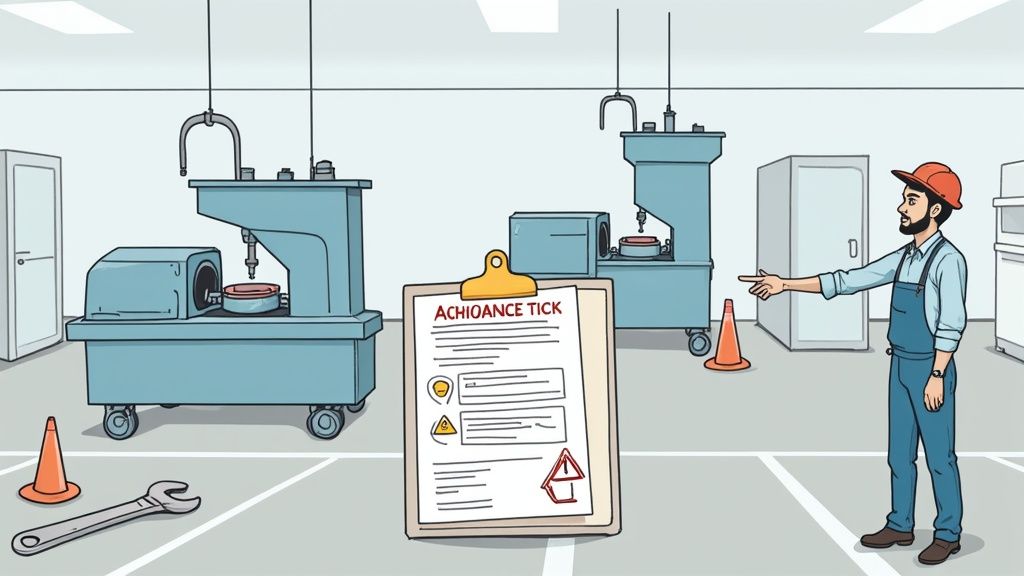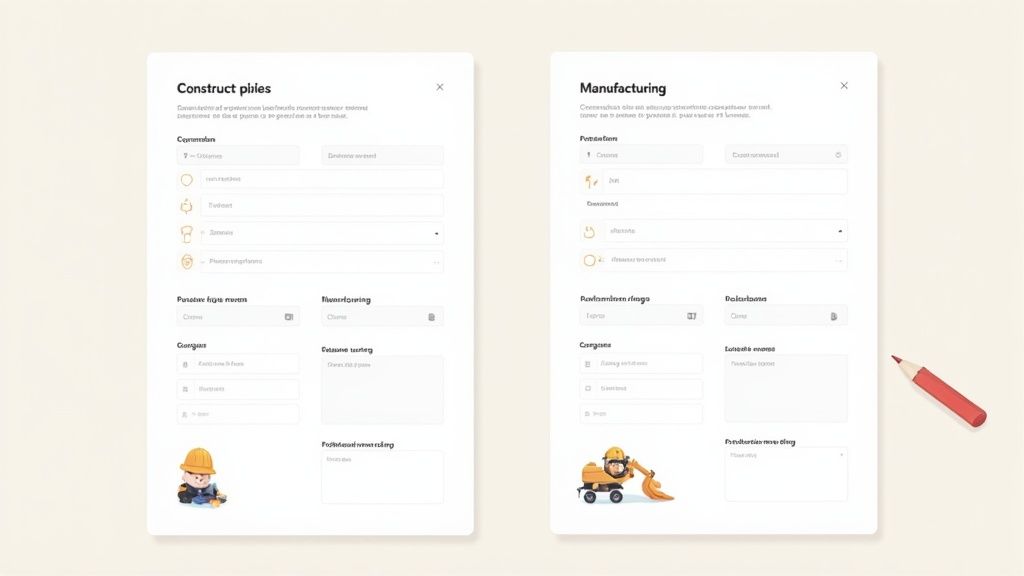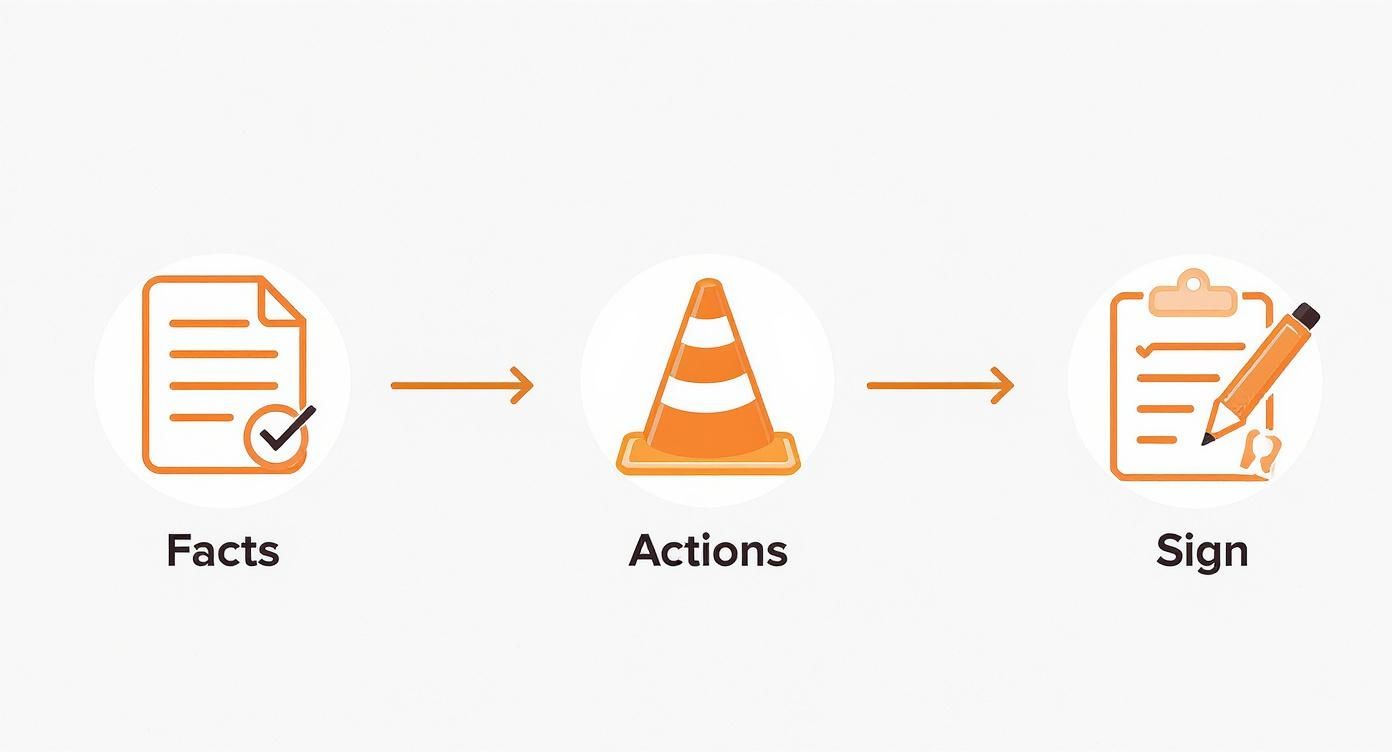Why A Good QLD Incident Report Template Matters

An incident report template for QLD is not just another form to file. It's a key tool for spotting workplace hazards. When teams fill out a clear, consistent report, you capture the "why" behind every problem. Over time, those reports show you where to make smart changes for a safer worksite.
Besides meeting your duties under Queensland’s Work Health and Safety (WHS) Act, a good template turns observations into useful data. Near misses, equipment acting up, or poorly lit walkways all get logged, looked at, and fixed.
For a deeper look into your legal responsibilities, check out our guide on Queensland WHS legislation.
A Real-World Factory Floor Example
Last year, a shift supervisor noticed a hydraulic press was acting strange. No alarms went off and nobody was hurt, but the machine hesitated during its cycle.
Instead of ignoring it, the operator filled out a near-miss report. He noted:
- The exact machine ID
- An unusual noise at 3:15pm
- The press’s cycle pattern
That simple report started an immediate maintenance check. A worn valve was found just before it could fail completely.
Thanks to that quick report, a serious hand injury was avoided, and the plant didn't have to deal with weeks of downtime and expensive repairs.
Understanding The Risks In Queensland
Queensland’s safety record shows why reporting is so important. In one year, the state recorded 53 work-related fatalities, the highest in the country. Behind each number is a story that might have been different with timely, accurate reporting.
Good data lets you find trends such as:
- The same faults happening on a few machines
- Dangers that appear at certain times or shifts
- Gaps in training for specific teams
Without a standard template, you're left guessing what went wrong. With one, you build a clear record of every problem and close call.
Core Components of a QLD Incident Report
Here are the key fields every QLD incident report template needs to be useful and meet the rules.
| Section Name | What Information to Include |
|---|---|
| Incident Details | Date, time, location, people involved, and a brief summary |
| Hazard Description | Exact nature of the hazard, equipment IDs, environmental conditions |
| Incident Type | Near miss, injury, property damage, environmental release |
| Witness Statements | Names, contact details and first-hand observations |
| Immediate Actions Taken | Emergency response, first aid, area isolation |
| Root Cause Analysis | Underlying factors, process failures or human errors |
| Corrective/Preventive Measures | Assigned owner, due date and risk rating for each action |
| Sign-Off and Review | Supervisor or manager name, date of review, follow-up verification |
Use this table as a checklist when you adjust or update your own template. It makes sure nothing gets missed and you keep a clear record.
A solid incident report template is the foundation of any good safety management system. It turns scattered notes into practical information, giving you what you need to protect your people and your business.
Getting Your QLD Incident Report Template Set Up

A generic incident report template is a decent start, but that's all it is. A truly useful document is one that fits your workplace.
When you make it specific to your operation, your team can fill it out faster and give more relevant details, whether they're on a big construction project or a busy manufacturing floor.
The goal is to build a form that gets the exact information you need to not only know what happened but also to stop it from happening again. This means adding details that are unique to your site. A generic "Location" field is okay, but "Site Area/Zone (e.g., Fabrication Bay 2, Level 3 Scaffolding)" is much better.
Must-Haves vs. Nice-to-Haves
Under Queensland's WHS legislation, some information is required. Your report absolutely must capture the basics: the date, time, location, and a factual, objective description of the incident.
But the real value comes from adding custom fields that give you better operational data.
Here are a few practical additions that work well in different settings:
For Construction Sites:
- Project Code/Name: Very important for tracking incidents across different jobs and clients.
- Specific Location: Think grid references, floor levels, or specific area names.
- Subcontractor Involved: A simple dropdown list of every company on site saves a lot of guesswork.
For Manufacturing Plants:
- Machine ID/Asset Number: Needed to identify faulty or problem equipment.
- Production Line: Pinpoints exactly where in the process the incident occurred.
- Shift (Day/Night/Afternoon): This helps you spot patterns related to fatigue, supervision levels, or time of day.
Putting these details into your template from the start saves you the headache of chasing the information down later.
A well-customised template makes it easy for a supervisor to log an issue with "Press #7 on the afternoon shift in the moulding department" instead of just writing "the press." That level of detail leads to real fixes.
Make Your Template Easy to Use
Here’s the thing: the easier your incident report template QLD form is to fill out, the better the information you’ll get back. A confusing or overly long document just discourages people from reporting well, especially when they're busy or stressed.
A great first step is to sit down with your team and review your current template. Ask them directly: which fields are confusing? Which ones seem pointless? You might be surprised what you learn. Removing unnecessary questions is just as important as adding new, relevant ones.
Next, think about ways to speed up data entry. Using dropdown menus instead of free-text fields is a great change. For things like "Incident Type" (Injury, Near Miss, Hazard, Property Damage) or "Body Part Affected," a dropdown not only saves time but also keeps your data clean and consistent for later analysis.
This simple change makes spotting trends over time very easy. At the end of the day, a template that helps your team report accurately and quickly is one that will actually get used.
Right, you have your customised incident report template QLD sorted. Now for the important part: making sure your team fills it out correctly every single time. A vague or half-done report is just a waste of paper, it doesn't help anyone improve safety on site.
The goal here is to be factual, clear, and objective. No guesswork, no pointing fingers. Let’s walk through the key sections of a report using a real-world scenario to see how it works.
Our Scenario: A hammer slips from a worker's hand on a second-level scaffold. It falls and strikes another worker on the ground, causing a minor cut to their forearm.
Section 1: Incident Details
This first part is all about setting the scene. It’s the who, what, where, and when. This isn't the place for vague descriptions; you need to be precise.
- Date and Time: Be exact. Don't just write "Tuesday afternoon." Use "Tuesday, 23 July 2024, at approximately 2:15 PM." This detail helps spot patterns later, like if incidents are happening during certain shifts or in specific weather.
- Location: "Construction site" is useless. Get specific. Think "Grid C-4, near the foundation of Building A, ground level." This helps investigators look at environmental factors.
- People Involved: List everyone directly involved and their roles. For our scenario, that would be "John Smith (Carpenter, injured person)" and "David Lee (Scaffolder, person who dropped the tool)."
- Witnesses: Anyone who saw what happened needs to be included. Jot down their names and contact details, like "Michael Chen (Site Foreman)."
Section 2: Description of the Incident
This is where reports often go wrong, but it’s the most important section. The golden rule is simple: stick to the facts. Don't include opinions, assumptions, or blame. Your job is to describe the sequence of events like a security camera would.
A terrible description would sound like this: "David was careless and dropped his hammer, hitting John who wasn't paying attention." This is just a blame game. It’s useless for any real investigation.
Here’s what a good, factual description looks like:
"David Lee was securing a plank on the second-level scaffold. As he reached for a nail, the hammer slipped from his grip. The hammer fell approximately 6 metres to the ground below, striking John Smith on the right forearm."
See the difference? It's completely objective. It states what happened without assigning blame, which allows for a proper investigation into the root cause. If you're looking for more guidance on this, our detailed article on the work incident report process offers more examples.
Section 3: Immediate Actions Taken
This section is your record of the immediate response. It proves you took control of the situation and acted to prevent further harm. This isn't about the long-term fix; it’s about what you did right away.
For our falling hammer incident, the immediate actions would look something like this:
- First Aid: "First aid was immediately administered to John Smith by the site's certified First Aid Officer, Sarah Jones. The laceration was cleaned and dressed on-site."
- Area Secured: "The area directly beneath the scaffolding in Grid C-4 was immediately cordoned off using safety cones and hazard tape to prevent further entry."
- Hazard Removed: "The hammer was retrieved from the ground by the Site Foreman, Michael Chen."
- Notification: "The incident was reported verbally to the Project Manager, Alan Grant, at 2:25 PM."
This list gives clear, documented proof that the situation was managed professionally from the start. It creates a solid record and shows a responsible approach, turning a simple form into a powerful tool for preventing the next incident on your site.
What to Do After an Incident Report Is Completed
Filling out the report is just the first step. The real value of an incident report template QLD is what you do with the information you’ve gathered. A form filed away won’t stop the next incident, but a solid follow-up process will.
First, you need a clear chain of command. Who gets the report once it’s submitted? Usually, this includes the direct supervisor, the Health and Safety Representative (HSR), and the site or operations manager. Everyone needs to know their part, whether that's starting an investigation or just confirming they’ve received it.
Establishing a Follow-Up Process
One of the simplest and most effective tools is a basic tracking log. This doesn't have to be a complex system, a simple spreadsheet is often enough to get started. All you need are columns for the report number, a quick description, the date it came in, who’s responsible for the follow-up, and its current status.
This simple act creates accountability. When every open incident is visible in one spot, things don't get buried or forgotten. It also makes it much easier to start spotting recurring patterns.
This infographic breaks down the basic flow, from getting the facts down to signing off.

It’s a great reminder that completing the form is a structured process, where each step builds on the last to create a solid record of what happened.
From Data Collection to Action
Now for the most important part: using that data to make real change. Set up regular review meetings, monthly or quarterly works well, to go through all the reports from that period. This is where you connect the dots.
Seeing multiple reports about slippery floors near the cutting machine in Workshop B? That’s not a series of one-offs; it’s a system problem that needs attention. A single clean-up won’t fix it. This insight points you toward investigating bigger problems, like poor drainage, the need for anti-slip matting, or a leaky coolant system on the machine itself.
By looking at reports as a whole, you shift from just reacting to events to fixing the root causes. This is how you break the cycle of the same incidents happening over and over again.
This kind of analysis is standard practice across Queensland’s high-risk sectors. From mining to custodial services, detailed reporting is key for tracking and managing safety. You can learn more about how Queensland uses data for incident reporting to drive improvements.
Once the immediate physical safety issues are handled, don't forget the digital side. It’s important to integrate findings into your wider efforts to build a comprehensive cybersecurity incident response plan, particularly if machinery or systems with digital controls were involved.
This entire lifecycle is much easier to manage with the right tools. A proper incident management system doesn’t just log reports; it helps you track actions, assign tasks, and analyse trends automatically, freeing you up to focus on keeping your team safe.
Even with the perfect incident report template QLD businesses can find, a few simple mistakes can make the whole document useless. When a report is well-intentioned but poorly written, it doesn't capture what really happened, making it impossible to learn from the event and stop it from happening again.
The good news is these common slip-ups are easy to fix. Most errors come down to vague language, missing details, or waiting too long to submit the report. Once you know what to look for, you can make sure every report your team completes is clear, factual, and helpful. If you're looking to improve your reporting skills in other areas too, looking at effective marketing report template resources can offer some good practices that apply across different fields.
Using Vague or Blaming Language
One of the biggest problems is subjective descriptions where objective facts should be. Phrases like "the worker wasn't paying attention" or "the machine malfunctioned" don't actually tell you anything useful. They're opinions, not observations.
- The Mistake: Writing "The worker was careless and slipped."
- What to do instead: Stick to describing the actual conditions and actions. "The worker was walking across the workshop floor, which was wet from a coolant leak. Their foot slipped, causing them to fall."
This factual approach takes blame out of the equation and puts the focus on the real issue, the coolant leak. You can't fix "carelessness," but you can fix a leak and put a better clean-up procedure in place.
Missing Key Information
It’s easy to overlook small but important details, especially right after an incident. Forgetting to get contact info for a witness or failing to write down the exact model number of a piece of equipment can create big problems later.
A few details are missed more often than others:
- Witness Contact Details: You might need to follow up a week later, so just getting a name isn't enough. Always get a phone number or email.
- Specific Equipment ID: Don't just write "the forklift." Get specific with "Forklift #FL-07." This helps you see if one machine is having recurring problems.
- Environmental Conditions: Was it raining? Was the area poorly lit? These details add important context and paint a complete picture of the incident.
Delaying the Report
This one is a killer for accuracy. Reports need to be completed as soon as possible after an incident occurs. Memories fade fast, and the details get fuzzy surprisingly quickly. Waiting a day or two to write everything down is a recipe for an inaccurate or incomplete report.
- The Mistake: A supervisor saying, "I'll get to it tomorrow."
- What to do instead: The report should be completed during the same shift while the events are still fresh in everyone’s minds. It ensures better accuracy and shows everyone that you’re taking the matter seriously.
Your Top Questions About QLD Incident Reporting, Answered
Let's get straight to it. Here are some of the most common questions from managers and workers about incident reporting in Queensland. The answers are based on QLD regulations and real-world situations.
When Do I Actually Have to Notify WorkSafe QLD?
You have to notify WorkSafe QLD immediately after you find out about a ‘notifiable incident’. This isn’t for every little thing, but for the very serious events.
So, what counts as "notifiable"? It comes down to one of three categories:
- The death of a person.
- A ‘serious injury or illness’. This includes things like an amputation, a serious head injury, or any injury that requires a person to be admitted to a hospital right away.
- A ‘dangerous incident’. This is a major near miss that could have killed or seriously harmed someone, like the collapse of a crane, an uncontrolled chemical spill, or an electrical shock.
For these major events, the first step is always to phone WorkSafe. After that, you have a 48-hour window to submit the official written report.
Can We Use a Digital Form Instead of a Paper One?
Yes, absolutely. For any busy worksite, digital templates are often a more practical choice. A digital form is fine as long as it captures all the required information and can be securely stored and accessed for review or by an inspector when needed.
Going digital makes it much easier to spot incident trends, forces all the required fields to be filled out before submission, and gets the report to the right managers instantly. The only thing to watch is making sure your system is reliable and everything is backed up properly.
A digital form makes the process faster and your data cleaner. It shifts reporting from a filing task to a useful tool for spotting patterns before they become problems.
What’s the Difference Between a Hazard and an Incident Report?
This is a simple but important distinction.
A hazard report is proactive. It's about flagging a condition that could cause harm later. Think of a frayed power cord on a grinder or an unmarked wet floor in a walkway. You report a hazard to get it fixed before anyone gets hurt.
An incident report is reactive. You fill one out after something has already gone wrong. This could be a first aid injury, damaged equipment, or a serious near miss. The point of an incident report is to create a clear record of what happened and why, so you can make sure it doesn't happen again.
Who's Actually Responsible for Filling Out the Report?
The person in charge of the area where the incident happened, usually the direct supervisor or manager, needs to complete the report. They have the most immediate knowledge of the work, the equipment, and the people involved.
But it’s not a solo job. It’s important they fill it out with input from the person (or people) involved and any witnesses. Getting everyone's side is the only way to make sure the information is accurate and you have the full picture. The person involved in the incident should always get a chance to review the report for accuracy before it’s finalised.
A solid reporting process is the foundation of any safe, well-run workplace. Safety Space provides a fully customisable Health and Safety management platform that gets rid of messy paperwork and confusing spreadsheets. Our system makes it simple to log incidents, track corrective actions, and spot trends before they turn into bigger problems. See how it works with a free demo.
Ready to Transform Your Safety Management?
Discover how Safety Space can help you build a safer, more compliant workplace with our comprehensive safety management platform.
Book a Free DemoRelated Topics
Safety Space Features
Explore all the AI-powered features that make Safety Space the complete workplace safety solution.
Articles & Resources
Explore our complete collection of workplace safety articles, tools, and resources.
